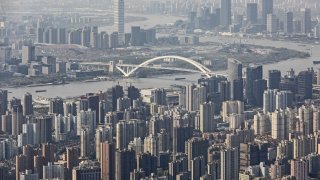
- China's services and consumption data of April came in strong, aligning with expectations of consumers leading the charge as pent-up demand is unleashed — but the broadening of the resurgence from services to goods was still limited.
- Georgios Leontaris, EMEA chief investment officer at HSBC Global Private Banking and Wealth, told CNBC on Monday that the combination of weak labor and goods demand may force the Chinese government and central bank into action.
- Despite the weakness in the April data, Goldman Sachs Chief China Economist Hui Shan said there has been little sign of imminent major macro policy easing, while the PBOC's first-quarter monetary policy report "sounded neutral."
China's much-vaunted economic rebound after its emergence from strict zero-Covid lockdown measures has yet to fully materialize, prompting some economists to speculate that further fiscal stimulus or monetary policy easing could be coming down the pipeline.
China's services and consumption data came in strong in April, aligning with expectations of consumers leading the charge as pent-up demand is unleashed — but the rebound in the call for services isn't yet spilling over into greater demand for goods, partly because unemployment remains high.
Major Chinese industrial firms' profits plunged 20.6% year-on-year between January and April. Manufacturing activity also contracted for the first time in three months, according to the Caixin China general manufacturing purchasing managers' index.
Feeling out of the loop? We'll catch you up on the Chicago news you need to know. Sign up for the weekly Chicago Catch-Up newsletter here.
Industrial production rose 5.6% on the year in April, marking an acceleration from the previous month but only hitting half the expected expansion rate among surveyed economists.
The job market also remains fragile. Data from China's Bureau of Statistics shows that 6 million of the 96 million 16 to 24-year-olds in the urban labor force are currently unemployed. From this figure, Goldman Sachs estimates there are now 3 million more unemployed urban youths relative to the period before the Covid-19 pandemic.
Money Report
In a research note Monday, Capital Economics assessed that, despite losing some momentum, China's economic recovery was still progressing at the start of the second quarter, with scope for further service sector-led improvement.
"Indeed, more timely data including those covering the Labour Day holiday suggest travel and consumer spending were still strengthening this month," China Economist Sheana Yue and Head of China Economics Julian Evans-Pritchard said.
"But with the challenging external picture continuing to cloud over the exports outlook, struggles in the housing market persisting, and extensive policy support unlikely, sequential q/q growth is set to moderate over the rest of the year."
More stimulus, targeted easing
Georgios Leontaris, EMEA chief investment officer at HSBC Global Private Banking and Wealth, told CNBC on Monday that the combination of weak labor and goods demand may force the Chinese government and central bank into action.
"The way that we see things is that China will have to deploy a little bit more fiscal stimulus, a little bit more targeted easing as well," he said.
"At the end of the day, unemployment, especially in the youth parts of the population, is too elevated, and they will have to bring that down in order to achieve their growth targets going forward."
The ruling Chinese Communist Party set an economic growth target of "around 5%" for 2023 — the country's lowest for more than three decades. China's GDP grew by 4.5% in the first quarter, as the economy emerged from strict Covid restrictions that were in place for nearly three years. It is widely expected to moderate these in the second quarter.
In March, the People's Bank of China announced that it would cut the reserve requirement ratio (RRR) for banks for the first time this year, in order to support the nascent economic recovery.
China's State Council in April announced a 15-point plan to more efficiently match young jobseekers to roles, but analysts have pointed to more long-term structural mismatches in the country's labor market.
Despite the weaker April data, Goldman Sachs Chief China Economist Hui Shan said there has been little sign of imminent major macro policy easing, while the central bank's first-quarter monetary policy report "sounded neutral."
"Many recent policy communications have focused on medium-term themes such as 'modern industrial system', 'unified national market', and the new financial regulatory framework," Shan noted last week.
"To be sure, interbank liquidity has been kept ample, and we think the central bank is likely to cut RRR in June to boost confidence. But we do not expect policy rate cut or major fiscal stimulus, barring a precipitous fall in exports in the coming months."
Any consensus among economists as to the trajectory of fiscal and monetary policy seems to be unraveling in light of the tenuous recovery.
Morgan Stanley suggested earlier this month that "measured additional easing" from the central bank could arrive from late June to late July, pointing to the limited spillover from the services rebound into goods and to an "incomplete" job market recovery.
"At the same time, infrastructure investment — a key support to the economy in the last 9 months to facilitate job gains — is decelerating amid rising funding pressure, following policy front-loading in 1Q," the bank's Asia Pacific research team said.
"With 2Q growth tracking weaker-than-expected and a negative output gap, job market pressure may persist and lead to social stability risk, we thus believe additional policy easing is needed to sustain recovery."






